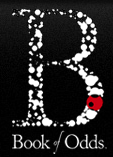Last night I attended the public launch of Book of Odds, a website that fulfills a need that I’m not sure exists with an operating model that’s reminiscent of the early days of the Web.
Book of Odds is about the likelihoods of everyday life. It can tell you, for example, that the odds that a white female will die from an accidental drug overdose in a year are one in 25,360 or that a major league baseball player hits for the cycle about as often as a pitcher throws a no-hitter.
 Interesting stuff, and if Book of Odds were a doctoral thesis, I’d say bravo. But this is a company with a significant investment behind it. “For the past three years, away from the eyes of the world, we have logged over 50 man-years to produce what we believe is the missing dictionary,” wrote president and founder Amram Shapiro in an invitation to the event.
Interesting stuff, and if Book of Odds were a doctoral thesis, I’d say bravo. But this is a company with a significant investment behind it. “For the past three years, away from the eyes of the world, we have logged over 50 man-years to produce what we believe is the missing dictionary,” wrote president and founder Amram Shapiro in an invitation to the event.
Fifty man-years is at least a $2 million investment by my calculation. It has produced an impressive resource that is unfortunately built on a top-down model that is rapidly passing from the earth. Book of Odds’ more than 100,000 statistics are the work of “talented researchers from top universities,” according to the FAQ page. Whereas most Web startups today are built on a crowdsourced or do-it-yourself model, Book of Odds has opted to make decisions about what it believes visitors need to know.
It has also invested in dozens of original articles created by professional writers who presumably don’t work for glory. There’s a staff, offices and the company is hiring. Who’s paying for all this?
That’s not clear. Book of Odds is privately funded. Marketing manager Ian Stanczyk told me the business is based on advertising and sales of branded merchandise. For example, you can have any odds statement emblazoned on a t-shirt. Assuming the venture has already burned through at least $3 million in startup costs, it’s going to need to sell a lot of t-shirts. Meanwhile, ad-based business models are a tougher sell than media stocks these days amid the glut of inventory.
Will They Come?
Equally baffling to me is the question of where the audience will come from. Book of Odds has some interesting information, but little that I would call essential or even compelling. Deriving value from its more than 100,000 statements requires an appreciation of the contextual and predictive value of statistics. I suspect that only a tiny percentage of the mathematically challenged American public will be up to the task.
I asked Stanczyk what market research the company had done to establish a need for its service. He couldn’t cite any, but he noted, “How many times have you asked yourself, ‘What are the odds of that?’” To be honest, not that often, and when I have, I’ve rarely felt an urge to rush to the computer to find out.
There’s no question that we need more tools to understand the statistics that continually assault us. A resource that mined public databases to create context from raw numbers could have great value. I would think that 50 man-years invested in building such a tool could yield something really useful. I’m not sure that Book of Odds is it.
I don’t mean to be too hard on the company, and I’ve certainly been wrong before. After all, I thought Meetup was a dumb idea when I first heard it. There is clearly passion behind Book of Odds, and the company’s About and FAQ pages suggest an almost academic rigor to its mission. The founders have created an impressive public resource that they’re giving away for free and they deserve our gratitude.
But the media geek in me says that this is a newspaper launching in an age of blogs, a 1999 business started a decade too late. The company will have to overcome big challenges to become a viable business. Fortunately, its staff is well-equipped to calculate the odds.

Hi Paul:
I’ve been playing on the site after reading your blog post – and have to agree with you. I can’t see Book of Odds going far for many of the reasons you’ve noted, but also because I find searching on the site difficult. The searches never gave me back what I was looking for and sometimes provided stats that I wasn’t interested in at all. I also found it tough to browse. Hopefully, they work out some of the kinks.